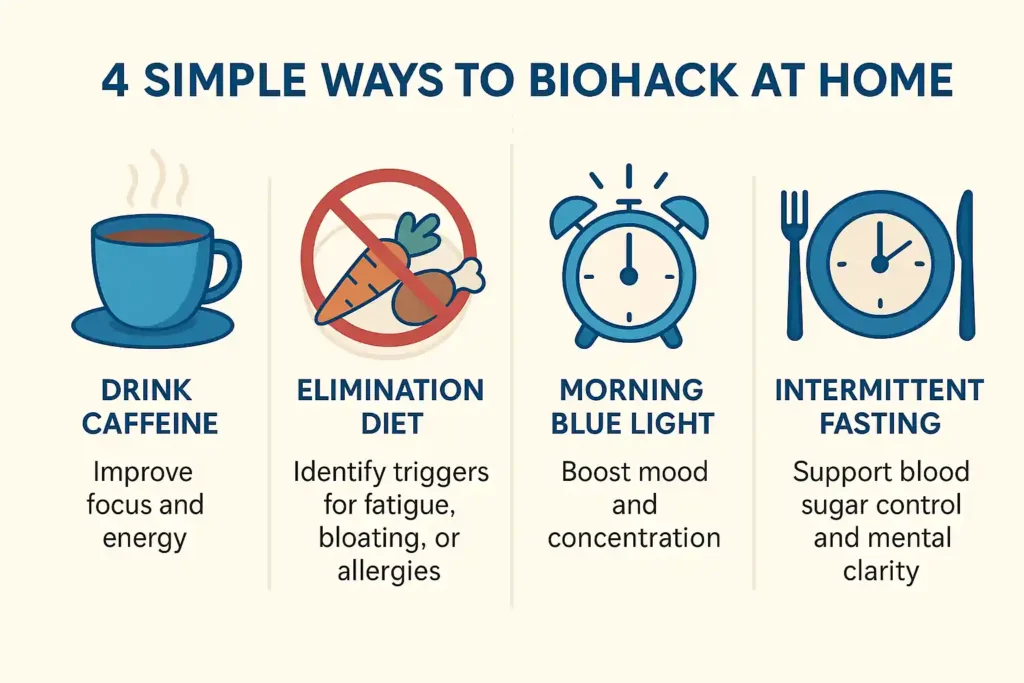What is biohacking?
Biohacking is the practice of making intentional changes to your body, habits, or environment to improve performance, health, and wellbeing.
Table of Contents
ToggleThe biohacking definition covers everything from adjusting your diet to installing microchips under your skin.
The biohacking meaning is simple: you test an idea on yourself, track the results, and decide if it helps. This could mean using supplements, changing sleep schedules, or using technology to monitor your biometrics.
People follow biohacking methods for different reasons; better focus, more energy, faster recovery, or even slowing down aging. Some rely on basic healthy habits, while others explore genetic biohacking using tools like CRISPR biohacking.
What are the different types of biohacking?

Different types of biohacking use different tools, knowledge, and goals. Three main categories stand out.
Nutrigenomics
Nutrigenomics studies how food interacts with your genes. By combining nutrition science and genetics, you can create diets that match your DNA.
For example, if tests show you metabolize caffeine slowly, you might cut coffee for better sleep. Nutrigenomics may also use DNA optimization for long-term health planning.
DIY biology
DIY biology, also known as DIY biohacking, caters to inquisitive individuals who engage in biological experiments beyond conventional laboratory settings. Some join community labs to test bioengineering ideas. Others study microbiomes, run nutrition trials, or explore gene editing.
Grinder
Grinder biohackers merge the human body with tech. This can mean implanting magnets for sensing fields, inserting chips for contactless payments, or using continuous glucose monitors for real-time sugar tracking. It’s the most invasive form of biohacking.
Does biohacking work?
It depends on the type and your goal. Some methods are backed by science, while others are experimental.
Does nutrigenomics work?
Early studies show nutrigenomics can personalize nutrition and help with conditions like obesity or vitamin deficiencies. But results vary, and it works best when combined with overall healthy habits.
Do DIY bio and grinder biohacking work?
DIY biology can lead to innovative ideas, but accuracy depends on equipment and skills. Grinder biohacking can work for specific goals, like constant health monitoring, but carries surgical and infection risks.
Is biohacking safe?
Not always. Safety depends on the method. Simple lifestyle changes like healthy habits, exercise, or meditation for biohacking are low risk. But genetic changes, untested supplements, or surgery carry big dangers. You should research, consult experts, and track your biometrics if you try anything beyond basic methods.
How can you use regular blood testing to biohack?
Blood tests give you data about your body. You can track vitamins, hormones, cholesterol, or inflammation levels. This helps you see if a diet or supplement is working. Over time, you can adjust your biohacking techniques for better results. For example, if your blood sugar is high, you might try diet changes or intermittent fasting.
What’s the difference between biohacking and biotechnology?
| Feature | Biohacking | Biotechnology |
| Purpose | Personal experiments for better health, focus, or energy | Large-scale science for medicine, agriculture, or industry |
| Who does it | Individuals, hobbyists | Scientists, companies, research labs |
| Scale | Small, personal | Industrial or research |
| Examples | Intermittent fasting, nootropics, DIY lab projects | Vaccine development, crop modification |
| Regulation | Rarely regulated | Strictly regulated |
How do you biohack with nootropics?
Nootropics are substances that may boost brain function. They can be natural, like caffeine, or synthetic. People use them to improve memory, focus, or mood. But effects vary. Some may cause side effects. If you try nootropics, start small and watch your body’s reaction.
4 Simple ways to biohack at home

You don’t need expensive gear to start. Here are safe and easy beginner biohacking tips.
1. Drink caffeine
Caffeine is the world’s favorite nootropic. It can improve focus, energy, and reaction time. Just don’t overdo it to avoid jitters.
2. Try an elimination diet
This involves eliminating specific foods from your diet for several weeks. Then, reintroduce them one by one to see if they cause problems. This can help with allergies, bloating, or fatigue.
3. Get some blue light for a mood boost
Blue light affects your brain and sleep cycle. A brief exposure to blue light in the morning can enhance mood and concentration. But avoid it at night so it doesn’t mess with sleep.
4. Try intermittent fasting
This means eating only during certain hours. For example, you might skip breakfast and eat between 12 p.m. and 8 p.m. Blood sugar, mental clarity, and weight control may all benefit from it.
The Takeaway
- Biohacking can range from coffee habits to gene editing.
- Start with safe, low-cost ideas before trying advanced biohacking methods.
- Track results using tools, apps, or biometrics.
- Safety should be your top priority in any biohacking guide.
- Long-term success comes from consistent healthy habits.
FAQs
What is an example of biohacking?
Using a continuous glucose monitor to adjust diet for stable blood sugar levels is a practical example of everyday biohacking that provides measurable health benefits.
How to biohack for beginners?
Focus on beginner biohacking tips like improving sleep, tracking meals, or trying short-term fasting while monitoring your biometrics to see measurable progress.
What are the main types of biohacking?
The types of biohacking include nutrigenomics, DIY biology, and grinder methods, each with unique biohacking techniques for personal health and self-optimization goals.
Do I need expensive tools or gadgets to start biohacking?
No, you can start with free or low-cost biohacking methods like diet changes, exercise tracking, or mindfulness biohacks before exploring advanced tech-based approaches.
Can anyone try biohacking?
Yes, but risky biohacking techniques like gene editing should only be done under expert supervision. Simple habits like meditation for biohacking are safe for most people.
What are nootropics in biohacking?
Nootropics are either natural or synthetic substances utilized in biohacking to enhance focus, memory, mood, or creativity by optimizing brain chemistry.
Is biohacking the same as self-optimization?
Yes, biohacking meaning overlaps with self-optimization, but biohacking often involves more data tracking and experimental lifestyle changes for measurable results.
How can I start biohacking safely?
Learn how to start biohacking with safe, low-risk methods. Monitor changes using biometrics, and avoid untested supplements or invasive procedures without professional guidance.
What are some popular tools and apps used in biohacking?
Common options include fitness trackers, sleep monitors, continuous glucose monitors, and diet apps for personalized biology tracking and progress measurement.

This article is medically reviewed by Dr. Nivedita Pandey, Senior Gastroenterologist and Hepatologist, ensuring accurate and reliable health information.
Dr. Nivedita Pandey is a U.S.-trained gastroenterologist specializing in pre and post-liver transplant care, as well as managing chronic gastrointestinal disorders. Known for her compassionate and patient-centered approach, Dr. Pandey is dedicated to delivering the highest quality of care to each patient.








